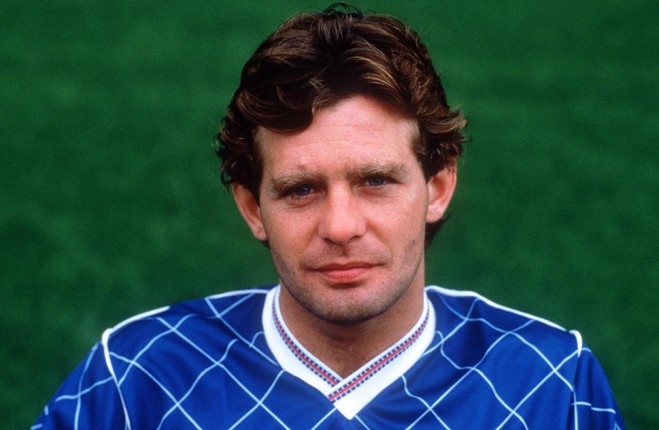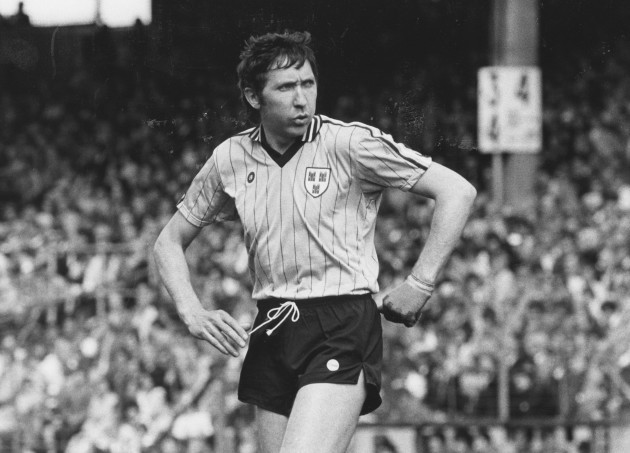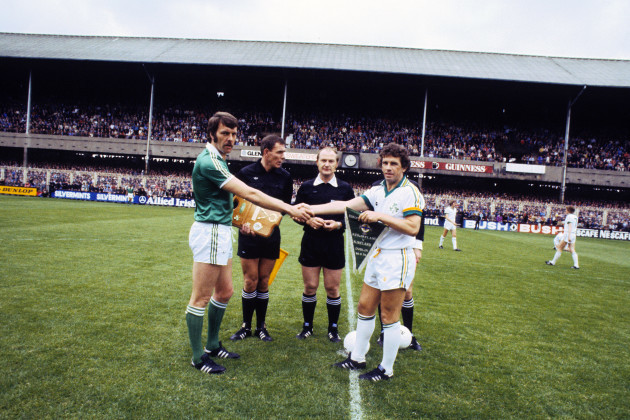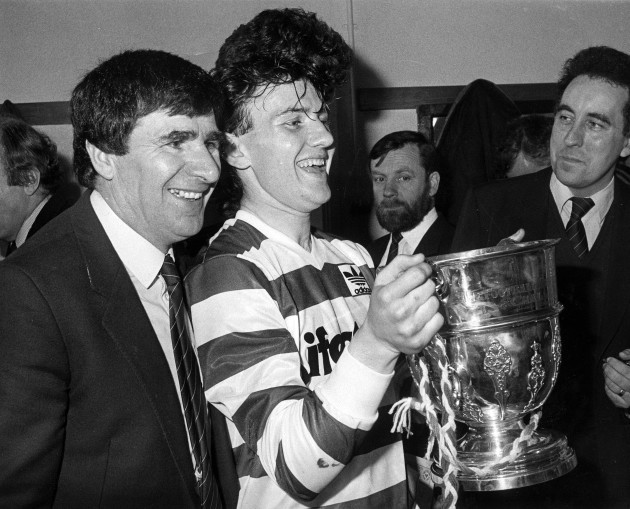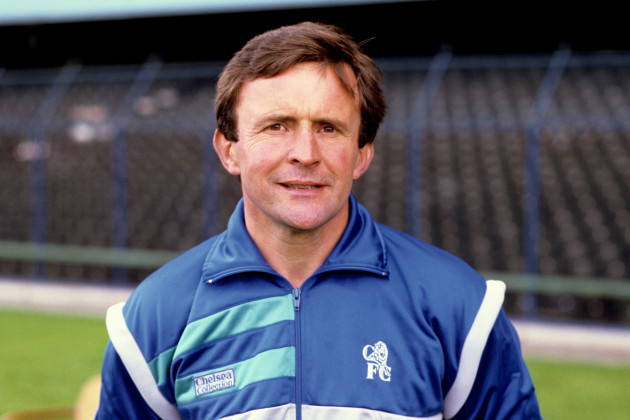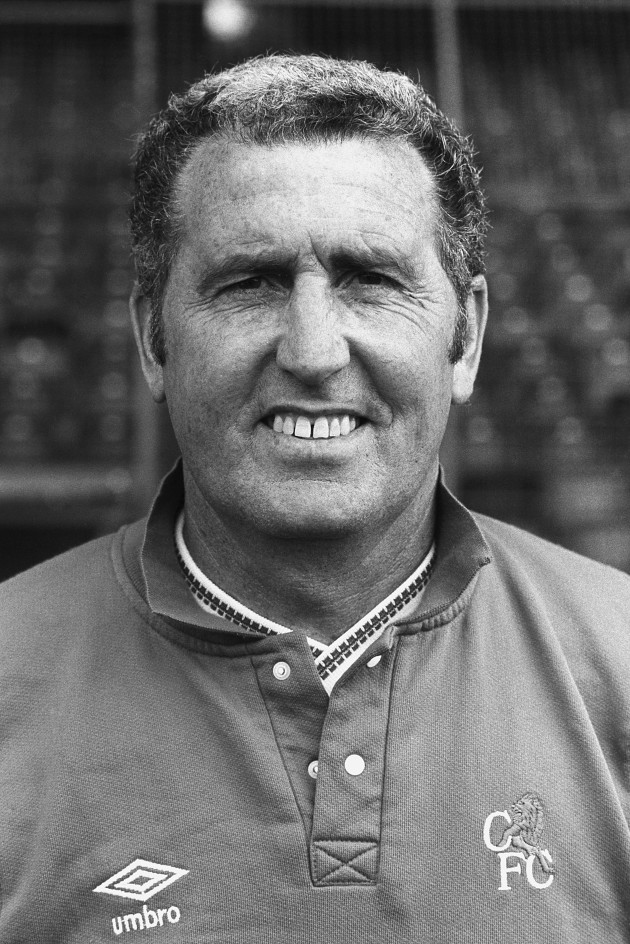FEW DIE-HARD football fans grow up to play for their favourite club — the team they have supported ardently all their life.
Even fewer get to star for that team, winning every domestic trophy imaginable, and ultimately establishing themselves as a club legend. John Coady was one of a select few in this regard.
Aged six, Coady was brought to his first Shamrock Rovers match in Milltown. His elder brother Tommy took him along. His memories of the game, such as who the opposition were, are vague.
“I was there sitting in the main stand, which was a bit of a change for [Tommy], because he was normally in the shed on the far side,” he tells The42. “Because he had a six-year-old with him, safety in those days was a precaution you had to take, because there were 15,000 people at the match.
“There was no way a child could go up on their own, because they’d be absolutely squished.
“But from nine on, I could go on my own and look after myself, so that was it then.
“We were from Groves Park in Rathmines, which was the first turn right up the bridge as you’re going up Rathmines Road.
“So it was a stroll down around Charlemont Street and you’d grab a ‘Football Special’ — special buses from Trinity College that would bring all the townies to Milltown in their droves.
By the time you got to Charlemont Street, you’d be hanging out the windows — it was like a train in Japan. So it was about a 20-minute walk up to Milltown from there.
“My main memory from childhood was the 1969 cup replay. Rovers played Cork Celtic in Dalymount on a Wednesday night after a very boring draw [in the first game], which I wasn’t allowed go to again, because of the crowds. Me and two friends managed to get the bus fare together. We didn’t even have the entrance fee. In those days, you’d get a lift over the stiles as a kid. [My friends] were slightly older, so they were the driving force behind it. That [4-1 win] was my main memory and it still is a great memory.”
He continues: “My parents weren’t influential at all [in cultivating that love of soccer]. I was the youngest in the family. I had three older brothers and two younger sisters. The two oldest lads were football fanatics, so it was from them I got the love of the game.
“They always say they were better players than me when they were younger, but they didn’t get the breaks I got, so you can read into that what you will. They were very good junior players. They played junior football around the city for several teams.”
Coady started out at schoolboy level with Leicester Celtic, before moving to Bushy Park Rangers and YMCA in Sandymount in later years.
Around this period, he was also an avid GAA player, representing Synge Street at senior level.
“We had a very good side at Leaving Cert standard, but just got pipped for a Dublin title,” he recalls. “[Dublin GAA great] Anton O’Toole, I was at his funeral a couple of months ago, he was playing. He was just on a different planet completely to the rest of us.
“I got the blame for giving the ball away [in one game] late on to Ballymun Kickhams. They went down the field and got the winning goal. The manager decided to give me an absolute rollicking after the match. I was kind of on the fence to stick with the GAA or soccer, so that completely made my mind up. He kind of did me a favour in one way. I didn’t mean to give the ball away, I was just a young lad.”
And does he feel he could have made it as a GAA star had it not been for this mishap?
“I don’t know if I would have had the mettle for it. It’s a tough game and getting tougher by the looks of it. But I was fully intent on trying for the Dublin panel if selected. So I was doing well and getting lots of scores.
“I probably wouldn’t have been strong enough in the end. I was a skinny young fella. They’re all big beefy chaps and they like to throw a dig or two, which wouldn’t be up my street really. So I probably made the right choice ultimately.”
While playing for YMCA, Coady did enough to attract interest from boyhood club Shamrock Rovers, and a trial was arranged.
I used to drink at a pub called the 51 on Haddington Road. There was a great mix of older lads and middling lads. We were kind of kids at the time. There was a big Rovers contingent there, especially a good pal of mine, Martin Nolan, who lived in Portobello, just around the corner from me.
“Martin had a word with me. Noel Campbell was the [Rovers] reserve team manager at the time. He said: ‘I’ve talked to Noel and you’re down for a trial. They want to have a look at you.’ I said: ‘Jaysus, that’s great Martin, lovely stuff.’
“I met [Martin] on a Tuesday night for training, he brought me up and he pulled up outside the sacred gates. He says ‘right, there you go’. I said: ‘Are you not coming up?’ ‘No.’ ‘Jaysus Martin, they’re not going to know who I am.’ He said ‘you’ll be grand’.
“So in I went anyway, and there was only one place I was going. I went into the first-team dressing room, sat down and nobody had a clue who I was. I introduced myself anyway and was told in no uncertain terms I could go to the away changing room where all the young fellas were. So that was the start of it.”
Coady made his senior debut for the Hoops in October 1982, away to UCD. It was towards the end of John Giles’ stint as manager. The Leeds and Ireland legend had come to the League of Ireland outfit amid great expectations, expressing hope that the club would soon be competing both domestically and in Europe on a regular basis.
“It was like going in for a trial with your local team, Liverpool, Manchester United, or Real Madrid, it was as big as that for me, it was absolutely huge. I was very nervous.
“Gilesy was very good to me, he was a fantastic manager. To get a break from somebody of his calibre, to throw you into the first team, I was as raw as anything. Looking back, it was a huge honour. I must have shown some ability, because he saw something in me, so I was over the moon, I couldn’t believe it.
“Alan Campbell wasn’t playing too well, he was playing up front with Liam Buckley. So he put me in up front. Things went well. It was absolutely brilliant.”
Ultimately though, Giles’ project failed to take off in the manner that had been hoped, with the 1978 FAI Cup the only major trophy they had won during the ex-Ireland international’s five-and-a-half-year spell in charge. The soon-to-be-RTÉ-pundit was replaced by Jim McLaughlin and trophies were acquired far more readily thereafter.
[Giles] was looking to build from within. He started that academy before academies. He started trying to bring certain players through the ranks, but I don’t think it would have worked [if he stayed]. I don’t think he had the contacts or possibly the foresight to see the players that were needed. McLaughlin just knew the game inside out. He knew what was required and did it.
“It seems like a dream to me in many ways. It’s still extraordinary times. Going into training, seeing the calibre of players you’re playing with and the standard. The training sessions and the build up to the start of the league, your pre-season, it was just wonderful.
“There was very little acrimony among the players. Everybody got on. If they didn’t, you sorted it out there and then. There were no cliques or anything.”
McLoughlin also made a decision that would have a pivotal impact on Coady’s career. The club’s regular left-back, Kevin Brady, had broken his ankle. The manager, along with assistant Noel King, persuaded Coady to move away from his normal centre-forward spot to do a job at full-back — a position he would primarily play in for the remainder of his career.
“Jim came to me one day and said: ‘Did you ever play left-back?’ ‘Oh yeah, of course I did. Loads of times.’ I’d only ever played there once in my life,” he remembers.
With Coady in the team, Rovers became what many people consider to be the greatest League of Ireland side ever, winning an unprecedented four consecutive league titles and two FAI Cups during a heady mid-1980s period.
“You can buy players left, right and centre. It’s all about knowing do they fit in or not. That’s the gift McLoughlin had. He knew a player that would suit the system he played. More than just the type of player, but someone who had the right personality and attitude. We never had any troublemakers in that four-in-a-row team. It was brilliant — everybody had one goal, go out and win the double every year.
“We used to have a meeting every Saturday morning. There would be serious arguments going on in the dressing room, but as soon as we went over the white line, boom.”
Moreover, of all the trophies he won, Coady considers the first of four league titles in 1984 as particularly special.
Rovers hadn’t won the league for 20 years. To win it up in Milltown and knowing half the crowd as well, knowing the faces. It was just amazing. From the end of the pitch to the changing room, you had to walk across a small car park, about 20-30 metres. I remember walking back towards the dressing room after the celebrations on the pitch and just seeing my second oldest brother Joe, who was a Rovers fanatic — he had big square glasses at the time. All I could see were the tears running down his face. That’s how much it meant to us, it was unbelievable really.
“I’m sure everyone was delighted, but I think there is a little more meaning to it if it’s your boyhood club. I think it absolutely does mean a bit more.
“Unfortunately, we were beaten in the cup final by UCD [that year]. It would have been the icing on the cake, but UCD just turned us over on the night [2-1 in a replay, after the first game ended 0-0]. It was a good lesson for us though. I think we were getting a bit big for our boots and that brought us straight down to earth.
“I knew then we wouldn’t be beaten [thereafter], so we went on to win the next three cups.”
There were also a number of memorable European nights against the likes of Honved, Linfield and Celtic.
“Every Sunday was just wonderful. You look around the dressing room and see the calibre of player we were playing with — Liam O’Brien, Pat Byrne, Mick Byrne, Mick Neville. All these guys were fabulous players, legends in their own right.”
Despite his clear passion for the club, Coady made the difficult decision to leave Shamrock Rovers in December 1986, moving to London and joining Chelsea in a £25,000 deal.
“It seemed to come about really quickly. I was talking to John Hollins about it. He said their scout in Ireland had been sending them clips from the newspapers and just a general report week in week out. I’d been playing particularly well at the time and getting a few goals, which was unlike me — I was more of a supplier of goals. So I was in the papers a lot.
“John Hollins chose the match against Hungary [for Ireland] in the Olympic qualifier to watch me. I played at left-back that night and must have done okay, because the following week, they came to me and said Chelsea want to buy you, so that was that.”
In April 1987, Coady made his senior Chelsea debut away to QPR, scoring his side’s only goal amid a 1-1 draw. The setting was not necessarily as glamorous as it might sound.
The plastic pitches in those days were like snooker tables. Blocks of cement with just a green beige yoke put over them. It was absolutely horrendous. But I managed to get on the end of a fantastic cross to volley in from five yards. That was a great start.”
The good times would not last for long, however. Coady would go on to make just 15 more appearances for the Blues, seven of which came as a substitute, while being played in different positions, which did hot help in trying to achieve the consistency he sought.
“When you’re in the first team, it’s fantastic and everything’s going well. But once you’re out of the team and you’re kind of struggling for form, [England is] a tough place to live. I was lucky, I got a great digs. The couple I was living with were fantastic, they were like surrogate parents almost. But if you’re not in the team, forget about it, it’s a nightmare.
“I was 26 when I moved. I wasn’t like a 17 or 18-year-old going over. I was much more mature than that and had been round the block a couple of times.”
Coady was at least playing under Hollins, though a four-month winless run in the league led to the manager’s departure in March 1988 amid a season that ended in Chelsea’s relegation from the English top flight, having finished sixth just two seasons previously.
Hollins’ successor, Bobby Campbell, immediately made it clear that Coady did not figure in his plans, and so began the most difficult spell of his career.
“I was just glad to be playing or on the bench even [under Hollins]. Once I was involved, I didn’t really care where I was playing. That could have gone against me.
“Then the new guy came in, he didn’t get on with me from the start. As soon as I saw him, I knew I was out the door. He made it perfectly clear I wasn’t playing in any of his teams, which was unfortunate really, because I enjoyed my time there.
“Roaring and shouting doesn’t work with me at all, whereas that would work with some others. I needed that kind of reassurance of playing every week. I could see the writing on the wall.
“It’s a lonely place to be. You’ve nowhere to turn to. Nobody’s on your side. No one wants to talk to you really. You’re kind of like: ‘What can you say?’
They had me training with the bleedin’ youth team at one stage, it was so degrading, just awful. I put in a transfer request and said: ‘Get me out of here as quick as possible.’ I don’t care where I go. On loan or anything, just to get away from you. But Jim McLoughlin came to my rescue, thank God.”
By that stage, Coady’s former Rovers boss was in charge at Derry, and he had recruited key Hoops stars, including Paul Doolin and Mick Neville, while talented local players like Felix Healy and Liam Coyle were also making an impact at the Brandywell.
Coady had offers elsewhere — Scottish team St Mirren and a Gillingham side managed by Damien Richardson were also interested, but the move up north ultimately proved an astute decision.
In his first season there, the Candystripes claimed a historic domestic treble. They are still the only Irish team to have done so and the feat that is being celebrated and talked about fondly to this day.
“The thing that stands out most for me was the supporters when you’ve got 11,000 people at home,” he says.
“Everyone else was struggling so badly at the time. We went on to Dundalk and played in the League Cup final, there must have been 6-7,000 Derry supporters at the match, it was absolutely incredible.
“You’d have 5,000 Derry supporters in Cork and they wouldn’t get home until God knows what time. They were so committed to it.”
Yet Derry were not able to enjoy the kind of sustained dominance that the Rovers side of the mid 198os had demonstrated. McLaughlin left in 1991, as did many of their top players, while Coady followed suit a year later, agreeing to a second spell at the Hoops.
But this stage though, the Dublin side were a shadow of their former selves — a team in transition on and off the pitch, they were still without a permanent home, having reluctantly waved goodbye to their beloved Glenmalure Park ground five years previously.
“[Ex-Ireland international] Ray Treacy brought me back. I got very sick about six and a half weeks into the season with glandular fever. I came back and it was like starting again, like pre-season, and it was after Christmas at this stage. So I got a couple of games in the end, but I wasn’t surprised when he released me at the end of the year.”
Monaghan was the player’s next destination. Moving to the newly promoted side was a step down for Coady, given the clubs he had previously play for, nonetheless he enjoyed his time at Billy Bagster’s ‘Blue Rinse Brigade’. It was there that the experienced defender managed to rediscover his form and fitness.
We trained out in King’s Hospital. Billy had a connection out there. A private school out on the M4 with acres of space. We’d come in on the Tuesday and Thursday, then in pre-season we had all day Saturday to train. They provided lunch for us as well. I was fit as a flea. I hadn’t been that fit for a long time. It was like being in the Betty Ford clinic. It was fantastic.”
Signing for Dundalk in 1994, Coady was joining a side that had finished eighth in the previous league season. Few people could have predicted what happened next.
Managed by Coady’s former Rovers team-mate Dermot Keely, the Lilywhites took the league by storm, though right up until the final day, a title win was looking unlikely.
They trailed leaders Derry by a point going into the last set of fixtures. The Candystripes just needed a win over already-relegated Athlone at St Mel’s Park to triumph. Nonetheless, they could only manage a 1-1 draw, with Shane Curran, better known as a Roscommon GAA goalkeeper, making a crucial penalty save.
All of which meant goals in the final 15 minutes at Oriel Park from Tom McNulty and Mick Doohan secured Dundalk a 2-0 victory over Galway and an improbable title win to boot.
“‘Surprise’ is an understatement. We were shocked as to how well we performed. We had some great players. I think five or six players started most of the games that were over 34. But everybody performed. Everybody was super fit. Dermot wouldn’t have it any other way.
“I’ll never forget the last day. Derry were down in Athlone. They needed to win. Athlone had scored after five minutes. Then Derry had equalised. So they were playing the remaining six minutes down in Athlone [as we waited in] Oriel Park. It was incredible. Then Stuart Gauld missed the only penalty he’d ever missed in his career to win the league. It was meant to be, I think.
“Derry were sick. Felix Healy was managing them. He refused to talk to me afterwards. It was a miracle. I don’t if you’ll ever see the likes of it again.”
After a memorable two years at Dundalk, Coady continued playing on into his late 30s, enjoying short stints at Home Farm, Drogheda and Monaghan, before finally retiring in 1999.
The situation is a stark contrast to nowadays, where the league is dominated by younger players, and the former star believes the game has changed irrevocably.
“You see some of the profiles of the players who are coming into the game now and they’re all kids. Maybe they’re feeding them something different nowadays.
There’s no way they’d have been able to survive in our league. They were an awful lot tougher. The stuff that went on was absolutely horrendous at times. You wouldn’t get away with it now in a million years.
“When we were playing, everybody was trying to break your leg. You had to mind yourself at all times. I was lucky enough I avoided any serious injuries. If somebody was there to be done, you went and done them. That was the end of it. No questions asked. But they expected it. Everybody was always on the lookout. You stretch out your leg and just leave yourself vulnerable to anything coming in over the top. It was mad, elbows flying all over the place.
“I saw Dermot Keely break Roddy Collins’ nose twice in the same match. It was nasty. It was great fun though.
[Diving] was nearly non-existent. One or two players in the league were good at it. But they’d always roll on a leg or something. They’d have to feel some contact. And they’d be absolutely laughed out of the ground. And that’s only by their players. That stuff does my absolute head in and it seems to be an accepted part of the game now.”
Coady balanced working for An Post with playing football for much of his career, and he remains there to this day. He did try out coaching, managing a junior team, before joining Longford as an assistant to Alan Mathews, but ultimately decided it wasn’t for him.
“I thought I loved football, but I didn’t love it that much, because I only lasted about four months.
“I was never at home. We were either on the training field, or travelling for a match. It was an eye opener for me, I don’t know how Alan did it, it was just insane.
“I’m glad I did it, because it gave me an insight into what was required.
“What I did miss the most [when I quit] was not really the football or the games, but the banter in the dressing room.”
Unsurprisingly though, Coady remains as fervent a follower of Shamrock Rovers at 58 as he was aged six.
“I’ve been a season ticket holder ever since they’ve been up in Tallaght. It’s been kind of an up and down ride. The Michael O’Neill days were brilliant and I’m sure Bradser will turn it around eventually and get some silverware.”
Whether they can come anywhere near matching his side’s four-in-a-row triumph remains to be seen, but Coady will as always be following them every step of the way like the rest of their hardcore supporters.
The42 is on Instagram! Tap the button below on your phone to follow us!
